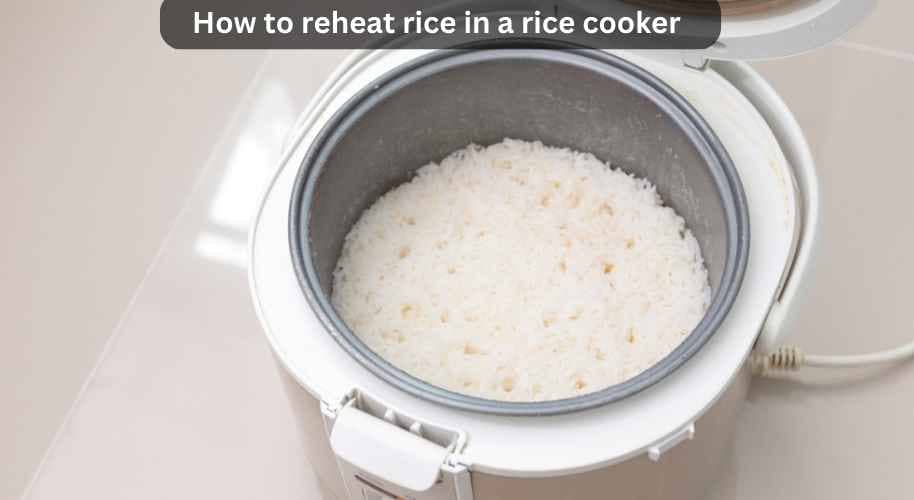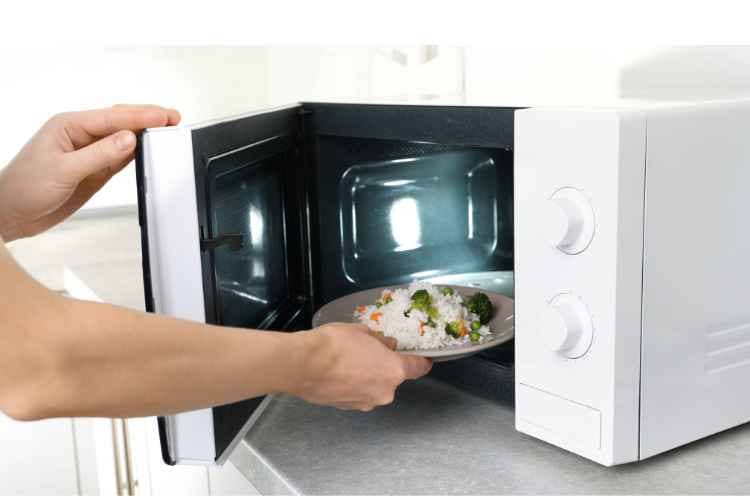Do you find yourself suddenly in need of reheated rice but don’t have access to a microwave? Are you considering the prospect of having to eat cold, unappetizing leftovers for dinner tonight?
Don’t despair—with a simple rice cooker and minimal effort, you can easily get freshly cooked hot fluffy rice ready for your meal.
In this blog post, we will provide step-by-step instructions on how to accurately and efficiently reheat your leftover rice using only a traditional home kitchen appliance!
Read on and learn how easy it is to turn yesterday’s plain old side dish into delicious warm rice.

Can you reheat rice in a rice cooker?
Yes, you can reheat rice in a rice cooker. The best way to do it is to put the cooked rice into the pot of your rice cooker and add some water or broth.
You can also add a bit of butter or oil for flavor. Reheating in a rice cooker is a safe and easy way to enjoy your meals without having to worry about over-cooking or burning the food.
Also read: Pollo tropical white rice recipe
How To Reheat Rice In A Rice Cooker?
Even if your modern rice cooker doesn’t have a specific “reheat” option on its control panel, there’s no need to fret.
Using the keep-warm function is an efficient and reliable way of reheating any type of rice without drying it out or making it go stale.
The slow heat applied will also make sure that the texture stays fluffy and delicious!
Here is a step-by-step guideline to reheat rice in a cooker:
Step 1
Start by transferring the leftover rice into your clean and washed rice cooker bowl.
Step 2
Use a spatula to fluff it up gently before adding a few tablespoons of water or stock for each cup of cooked rice — this will help keep the grains moist and prevent them from drying out during reheating. Add 1 or 2 tablespoons of water per cup of rice for best results.
Step 3
Secure the lid and press the ‘Keep Warm‘ button on your rice cooker.
Step 4
The cycle will take around 10 to 15 minutes, depending on the type of rice you’re reheating. No need to stir, dilute further or monitor the heat constantly during the reheating process.
Step 5
Once it’s finished, turn off the heat and leave the lid closed for at least 5 minutes. This will help the steam inside finish cooking and soften the grains even more.
Step 6
Finally, fluff the rice with a fork before serving it for your meal!
Also read: Can you put a ceramic bowl in an air fryer
What is the best way to reheat rice?
Reheating your white rice or brown rice serves two goals. Not only are you rewarming the dish, but it’s also a great opportunity to add moisture back into the grains and make them as fluffy as when they were first cooked!
Additionally, many people enjoy adding oil or butter to their portion of rice. This is simply up to individual preference and is totally optional.
Here are the three best ways to reheat your rice:
In the Microwave

One of the quickest and most convenient ways to reheat rice is in the microwave. Simply place the rice in a microwave-safe bowl and add a few splashes of water. Cover the dish and heat on high for 1-2 minutes or until the rice is heated through.
On the Stovetop
Another way to reheat rice is on the stovetop. Simply place the amounts of rice in a saucepan with a lid and add a few tablespoons of water. Heat over medium heat until the water comes to a boil, then reduce the heat to low and simmer for 5 minutes or until the rice is heated through.
In the Oven
If you’re looking to reheat a large quantity of rice, the oven is your best bet. Preheat your oven to 350 degrees Fahrenheit and spread the rice out on a baking sheet. Bake for 10-15 minutes or until the rice is heated through.
What’s even more incredible is that these methods work on every type of rice, from white to brown or basmati rice.
Also read: Dominican red beans and rice
FAQs
How To Store Leftover Rice?
To ensure that your leftover rice remains safe to eat, the United States Department of Agriculture (USDA) recommends cooling it quickly after cooking.
This is important since leaving cooked food lingering in temperatures between 40 F and 140 F for an extended period can create a dangerous zone where bacteria may grow.
Cool the rice: Before storing leftover rice, it’s important to let it cool completely to room temperature. Storing hot rice can create steam and moisture in the container, which can lead to spoilage.
Transfer the rice to an airtight container: Once the rice is cool, transfer it to a clean, airtight container. This will help prevent contamination and keep the rice fresh.
Refrigerate or freeze the rice: To extend the shelf life of leftover rice, it’s best to store it in the refrigerator or freezer. In the refrigerator, leftover rice will keep for 3-4 days. In the freezer, it will keep for up to 6 months.
Can You Reheat Rice That Has Been Refrigerated?
Yes, it is generally safe to reheat rice that has been refrigerated, as long as you store it properly and it has not been left out at room temperature for an extended period.
It’s important to make sure that the rice is heated all the way through to eliminate any potential growth of bacteria that may have formed while it is stored in the refrigerator.
Is Reheating Rice Toxic?
Reheating rice is generally safe if it is stored and properly reheated. However, if rice is not stored correctly or left out at room temperature for an extended period, it can promote bacteria growth, like in cold rice, which can cause food poisoning.
If you consume rice contaminated with Bacillus cereus bacteria, you could suffer from vomiting or diarrhea within 1 to 5 hours afterward.
Conclusion
Thanks for reading our guide on how to reheat rice in a rice cooker! We hope it helps you enjoy your meals without having to worry about over-cooking or burning the food.
Remember, always make sure to use clean and washed utensils while preparing food and keep leftovers refrigerated until ready for reheating. Now get cooking!
Please share any tips you might have for reheating rice in a rice cooker in the comments section below!
We’d love to hear from you. Enjoy your meal and Bon appetite!
Sharing is caring!
My name is Lori Walker. I’m a registered dietitian, food blogger and food enthusiast. I share easy healthy, delicious recipes on my blog and review necessary kitchen items. The recipes I share take less… Read more
